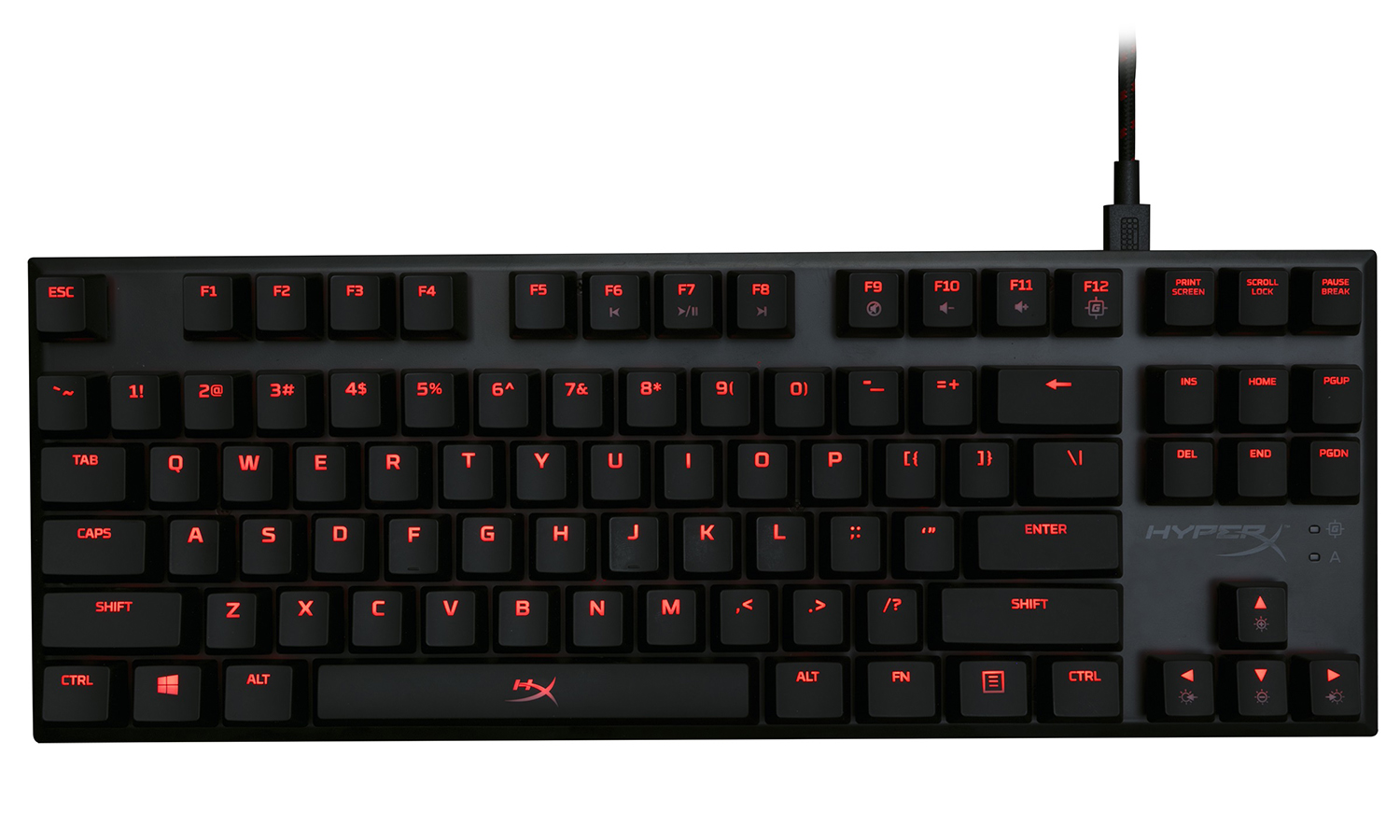Tom's Guide Verdict
The HyperX Alloy FPS is a straightforward, functional peripheral with excellent mechanical switches and no software to bog things down.
Pros
- +
Streamlined design
- +
Authentic Cherry MX switches
- +
Braided, detachable cord
- +
No extraneous software
Cons
- -
Limited customization options
- -
Gaudy backlighting
Why you can trust Tom's Guide
HyperX hasn't been making keyboards for that long, which makes it all the more impressive that its early efforts have been, by and large, really good. While the HyperX Alloy Elite ($110) offered full-size thrills, its tenkeyless cousin, the Alloy FPS Pro ($100), cuts the size without cutting much of the functionality. While the Alloy FPS has dropped a few of my favorite features from the Elite, it's also a straightforward, functional peripheral with excellent mechanical switches and no software to bog things down.
Design
For better or worse, the Alloy FPS is plain. It's a black tenkeyless peripheral with very little in the way of borders. The baseboard is very low, giving the keys a cool, elevated appearance. There's also red backlighting, which you may or may not want to use. (I didn't; red backlighting has always looked gaudy to me, but if you want more options, get a more expensive keyboard, I guess.)
Since the Alloy FPS Pro is smaller and cheaper than the Elite, it lacks the latter's discrete media controls and its removable wrist rest. Both of these were incredibly useful features, although they're not strictly necessary for a smaller keyboard that might be subjected to frequent travel.
In fact, the Alloy FPS Pro comes with a detachable, braided micro USB cord for power — which is useful for tournament players. On the other hand, it doesn't come with a carrying case, as some tenkeyless Razer models do, which would have been helpful.
Keys
The biggest argument in favor of the Alloy FPS Pro, compared to most other tenkeyless mechanical models, is that it comes with authentic Cherry MX keys — your choice of soft Reds, tactile Browns or clackety Blues. (The Corsair Vengeance K65 offers this as well, and for a lower price, but doesn't have backlighting, and offers only Red switches.)

Other key switch manufacturers have made great strides in recent years, whether they're Cherry copycats like Kailh or original ideas like the Logitech Romer-G. Even so, nothing can quite match the great German juggernaut when it comes to comfort and speed.
Using TypingTest.com to evaluate, I scored 125 words per minute with three errors on the Alloy FPS, as opposed to 123 words per minute with five errors on my usual Logitech G810. The difference is not significant, save that I work with the Logitech every day, and had used the Alloy FPS for only a few hours.
Get instant access to breaking news, the hottest reviews, great deals and helpful tips.
Features
The Alloy FPS Pro eschews customizable software, opting instead to assign a few simple options to the function keys. Although I do like the functionality that comes with a good piece of keyboard software, it's also nice to just plug in a keyboard and have it work without having to spend 10 minutes tweaking options before you play a game.

One combination of buttons turns on a Game Mode, that prevents you from accidentally bringing up the Windows button during a heated match. Other combinations control media functions, or adjust the backlighting. You can turn the lighting on and off, or set it to one of several patterns, including static, breathing, wave and responsive modes. It's a nice touch, although I was perfectly happy to turn the backlighting off altogether.
There's really not much else to say about the Alloy FPS Pro; it's a remarkably simple, straightforward device, which is a selling point in and of itself. You can't reprogram keys, as you could with a software-enabled peripheral, but you'll also never have to worry about an application hogging your resources or exhibiting buggy behavior when you need it most.
Performance
I spent some time in Overwatch in order to evaluate how well the Alloy FPS Pro lived up to its name. I didn't miss the numpad at all, but I did appreciate the crisp Cherry keys as I took control of Soldier: 76, sprinting after opponents, gunning down targets and lobbing explosives. The Alloy FPS Pro isn't really "better" than any comparable keyboard with high-quality mechanical switches, but its name is well-earned, at least.

As suspected, the keyboard acquitted itself well with other genres as well. It stood up to commanding Terran armies in StarCraft: Remastered, playing rounds of Gwent in The Witcher 3: Blood and Wine, and hurling Captain America's shield at HYDRA foes in Marvel Heroes Omega.
Bottom Line
HyperX's entire modus operandi thus far has been to strip pretense and excess out of gaming peripherals, and make them streamlined and approachable instead. The Alloy FPS Pro demonstrates that the company can make intelligent subtractions from its products, if necessary, instead of additions. While I miss the discrete media keys and the wrist rest, the Alloy FPS isn't here to be your everyday work companion; it's here to help you hone your tournament skills, and maybe even win one.
The red backlighting limits the peripheral's aesthetic appeal, and its lack of reprogrammable buttons might be a drawback for customization diehards. Nonetheless, the Alloy FPS Pro does exactly what it was designed to do, and at a reasonable price. It may not make you a better FPS player, but it'll sure make you comfortable while you play.
Credit: HyperX

Marshall Honorof was a senior editor for Tom's Guide, overseeing the site's coverage of gaming hardware and software. He comes from a science writing background, having studied paleomammalogy, biological anthropology, and the history of science and technology. After hours, you can find him practicing taekwondo or doing deep dives on classic sci-fi.

